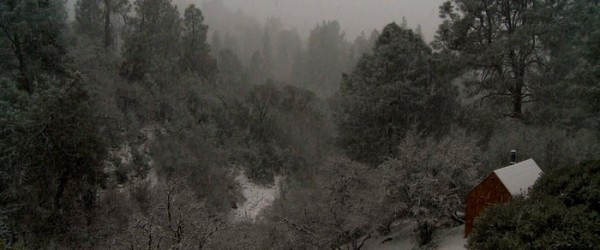
VIFF 2013 Review – Stemple Pass
Film, ReviewsJames Benning’s Stemple Pass comprises four static, high-definition shots of a cabin in a forest. Each of the shots correspond to a different season; time is organized to expand and embody the narration of diary entries and letters written by Ted Kaczynski, more famously known as “The Unabomber,” while he lived in solitude in the woods.
Narrated by the avant-garde visual artist himself, Benning also made a replica of Kaczynski’s cabin. This replica is the cabin featured in the film, much like the film is an attempt to recreate Kaczynski’s experience—with the hope of recreating that recreation of experience in the viewer.
The first segment of the film establishes Kaczynski’s love of nature, describing his hunting techniques and fondness for squirrels. Benning’s excellence as an artist is demonstrated by the selection that he chooses to introduce Kaczynski’s journals. In an intimate voice that does not overwhelm the sounds of nature in the shot, Benning narrates Kaczynski’s understanding of the wild: Kaczynski tells us he doesn’t enjoy killing squirrels. Yet, he makes a squirrel trap, and is thankful for the food. In subsequent shots, Kaczynski’s details of his terrorist activities feel jarring in contrast to the quiet scene, but as one gets to know Kaczynski, and learns to listen in many ways, sympathy for the neo-Luddite anarchist grows, with room for criticism.
Despite the fact that permission was not sought from Kaczysnki before the film, and that Kaczynski would likely have disapproved of the usage of this digital medium, it may be challenging to find a better film that allows for the complexity of Kaczynski’s principles, and constantly changing “nature,” the experience of which is dependent on the viewer’s level of engagement, attention and reflection.
The defining beauty of Stemple Pass lies in its method and craft, which reflects contradictory nature as we learn it through Kaczynski’s writing and experience. It is easy to forget that one is engaging with a simulation. Just as Kaczynski comes to understand nature and the wild by simultaneously revering and indulging, so does Benning when he transposes this contradiction using self-reflexivity to create a shared, authentic experience. And, his use of digital media situates Kaczysnki’s story in the present, building on the universality of their respective principles, in fact emphasizing their shared values, even though it may not seem to be the case at first.
Stemple Pass not only delivers an experience of contemplation and self-reflection, but comments on the experience of nature in the present—including its technological elements. Beyond the experience, Stemple Pass is ultimately a selfless work of art that is quietly potent with empathy. Stemple Pass is certainly a refreshing addition to VIFF 2013 programming.






















